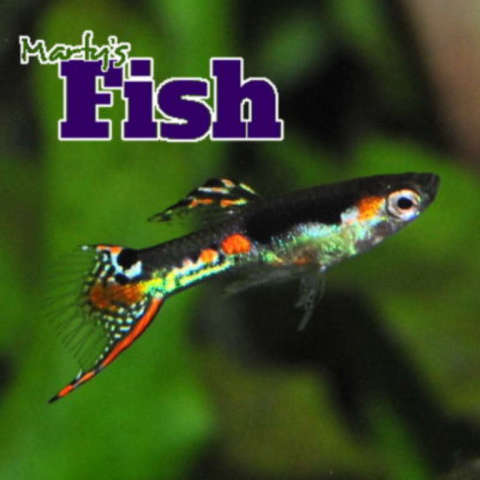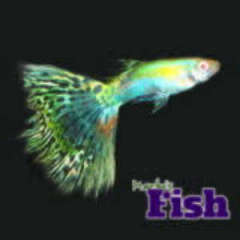Endler Fish
Endler fish (Poecilia wingei), also known as Endlers, Endlers Livebearers, ELB, Endler Guppies, Cumana Endlers, Campoma Endlers, are a small livebearer fish that originates in the Cumana & Campoma regions of Venezuela.
First discovered by Franklyn F. Bond in 1937, these little gems where forgotten until they where rediscovered in Laguna de Patos in the Cumana region of Venezuela by John A. Endler in 1975. Many of the first strains offered in the United States were introduced by breeder Adrian Hernandez after they had been collected by Armando Pou.

Since their introduction into the tropical fish hobby in the late 1900s these beautiful little fish have become increasingly popular.
This small colorful fish is very easy to care for and is a pleasure to watch. They are extremely active and will explore the entire aquarium rather than just staying at the top or bottom of the tank.
Another reason Endlers are so popular is due to their amazing coloration. In fact it is the metallic green coloration found on many of the Endler strains that first caught the attention of John Endler when he rediscovered them.
Although metallic green is found on many Endler strains there are several other bright colors that may be found on Endlers including orange, red, blue, yellow, white, black and purple.
What Is The Difference Between Endlers and Guppies?
What’s the difference between Endlers and Guppies? Many hobbyists would say nothing! Endlers are so closely related to guppies that they will readily breed with guppies and will produce fertile hybrid offspring.

Male Orchid Endler 
Male Fancy Guppy
This close relationship with has been the topic of dispute among tropical fish hobbyists for years. While genetic testing has indicated that Endlers are their own unique species (Poecilia wingei), the fact that they can so readily produce fertile offspring with guppies (Poecilia reticulata) cause many tropical fish hobbyists to disagree with the classification of Endlers as their own species.
This is one of the reasons that Endlers Livebearers are often referred to as Endlers Guppies.
Endlers closely resemble wild guppies and don’t have the fancy fins that are commonly found in Fancy Guppies. Endlers also tend to be much smaller than Fancy Guppies sold today.
What Do Endlers Eat?
Endlers are undemanding when it comes to food however the food must be small enough for them to eat. Endlers will readily take crushed flake food or small Golden Pearls.
They also enjoy baby brine shrimp as well as some commercially available very small pelletized food.
Endlers should be fed small amounts at least two times a day however several small feedings a day is best.
Avoid the temptation to feed Endlers more than they can eat in a couple of minutes as this can lead to wasted, uneaten food that can affect water quality.
Are Endlers Easy to Care For?
For the most part Endlers are one of the easiest species of freshwater fish to keep in a home aquarium. While they may be kept in small desktop bowls, Endlers will do best in 10 gallon tanks or larger. We find 40 gallon breeder tanks work great as they minimize the affects of temperature and water quality changes.
Endlers should be kept in a heated tank as Endlers prefer water temperatures that are warmer than most other tropical fish. Water temperatures between 78° and 80° Fahrenheit seems to be ideal for Endlers.
Endlers seem to prefer lots of live plants in their aquarium. Thick plantings of live plants help the Endlers to feel more secure and also help to minimize the affects caused by fluctuations in water quality.
Do Endlers Have Special Water Requirements?
Endlers were originally found in bright green, algae filled brackish water. The water was quite hard and it is believed that they will do best in similar conditions.
We have found that Endlers are highly adaptable when it comes to water parameters and find that modifying the condition of the water is usually unnecessary.
Just like any other tropical fish the tank should be properly cycled and there should be no traces of chlorine or chloramine which are both commonly used to treat municipal water supplies.
Endlers seem to be sensitive to high levels of ammonia or nitrites. Ammonia and nitrites are produced from fish waste and from decaying food or plants.
Overcrowding of Endlers should be avoided to help control fluctuations in water quality. Partial water changes also help to prevent high levels of ammonia and nitrites as well as nitrates. We have also had great success with low tech tanks which require very few partial water changes.
How Do You Breed Endlers Livebearers?
Breeding is as simple as putting a male Endler in a tank with a female Endler. Because male Endlers will endlessly pursue female Endlers it is best to keep more females than males. Those who wish to breed Endlers often purchase them in trios which consists of one male and two females.
Because Endlers are thought to be Endangered and some strains are thought to be extinct in the wild breeders may wish to obtain pure Endlers that have documentation of where they came from.
To help make it easier for those who wish to keep pure Endlers to know what they are getting an Endler classification system was created. The Endler Classification System categorizes Endlers into three classes. N Class, P Class and K Class.
N Class Endlers: Any Endler’s Livebearer (and progeny) that can be shown to have originated from their native waters in Venezuela will be considered a ‘Class N’ Endler.
P Class Endlers: Class P: Any fish of unknown origin but appearing to be an Endler’s Livebearer based on the characteristics of size, shape and color will be considered a ‘Class P’ Endler.
K Class Endlers: The progeny of any Endler’s Livebearer crossed with any other livebearer or any Hybrid strain will be considered a ‘Class K’ Endler.
This classification system helps those who wish to purchase pure Endlers to know where their Endlers came from so they can see that they came from the native waters of Venezuela or if there is the possibility that the genetics have been contaminated by guppy genetics or other livebearers.
Care should be taken however because this system is not foolproof as there are many that sale Endlers as pure N Class Endlers when those with a trained eye can see that they are hybrids.
For this reason it is recommended that pure Endlers be purchased from reputable dealers and hobbyists.
It is also important that those who offer Endlers clearly identify if an Endler is a hybrid or not. If you are unsure you should assume that the Endler genetics are not pure and are likely hybrids.
Is It Wrong to Keep Hybrid Endlers?
Guppy/Endler hybrids offer a new and exciting opportunity for tropical fish hobbyists. With the wide variety of guppies available and the number of Endler strains available today the possibilities are endless.
Arguably many of the Endler/Guppy hybrids are more beautiful than guppies or Endlers and adding Endler genetics to guppies may help to make them healthier as many guppy strains have become weak due to inbreeding.
Many Endler/Guppy hybrids are difficult to distinguish from pure Endlers however many of them tend to be larger in size and have a thicker body appearance.
Hybrid Endlers should clearly be identified as hybrids to avoid confusion between Endlers, guppies and hybrids.
Many hobbyists believe that Endlers are destine to become hybrids over time as populations of pure Endlers are mixed with guppies.
The Joy of Keeping Endlers
Whether you keep pure N Class Endlers or hybrids we find that Endlers have a lot to offer freshwater tropical fish hobbyist. Male Endlers are constantly displaying to female Endlers and Endlers tend to use the entire tank.
We find Endlers to be much more active than Fancy Guppies and there coloration and patterns are amazing.

I am curious and have not been able to find this information in my searches (unless I’ve missed it)…There is a lot of info about there about male Endlers but not so much about females. I have orchid Endlers and some of my females are a more of a golden color and others more of a grey color. Any info about this? Thanks in advance.
That’s a great question. Thank you for bringing it to our attention. We may have to work on sharing more information about female Endlers.
There are definitely lighter colored females as well as males. These may be what is known as Blond or Gold Endlers.
If your Endlers carry the genes for that coloration it may not be seen until thousands of fry are born.
Due to their coloration, this genetic variation is easier to see, at least to the untrained eye, than it is in female Endlers.
Coloration can also be affected by the Endlers habit, lighting and food.
When I was fishing a small creek I discovered a large community of Endler Guppies. At the time that I discovered this group, it was 1988.
I was 13 years old and had never seen or heard of an Endler.
The creek that I was fishing had a spring as it’s source. It was extremely clean and clear water and literally bubbles up out of the ground in the middle of nowhere in outback Australia. Not ten metres from the source, it opened into a small round pond approximately 2 metres in diameter and about 50cm deep. There was a lot of vegetation growing in the water, proper water plants, water grass.
There was a couple of resident long fin eels, about the size of a adults arm.
Hundreds of baby eel, so small they were transparent and not longer than a finger.
When I first saw the Endlers, I assumed that they were offspring of someone’s fancy guppies that had been thrown into the creek that had bred with the local wild creek guppies.
The wild guppies we have here in Australia are completely void of any colour whatsoever. Just a plain silver/grey. So I was very surprised to see years later that they were actually a different species.
These particular Endlers, had to have been living wild in this spring for decades, because in the part of Australia they were, there is simply nobody lives there, especially a population that would have had a aquarium at any stage. So the Endlers must have dropped there by someone, but no way was it after 1988.
Sounds like ideal conditions for them.
While it would be more likely that they are guppies that have reverted back to “wild type” I would suppose it’s not out of the realm of possibilities that they are in fact Endlers as they were first rediscovered in 1975.
Any that I have heard of all ended up in Europe but someone could possibly have taken some to Australia.
There are some wild guppy populations that are very colorful. Some of them are sometimes confused with Endlers due to the amazing coloration.
I recall some absolutely beautiful wild guppies living in a stream in the Philippines back in the mid 80s. I wish I had some of them now.
Whether they are guppies or Endlers it would be an exciting find if they were still at that location.
I would love to see a picture of them!